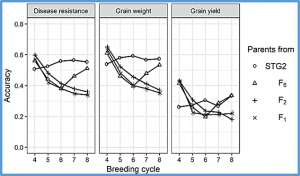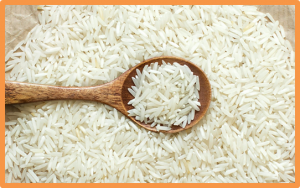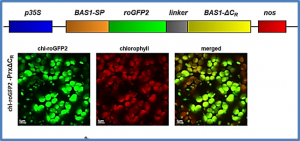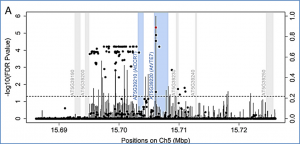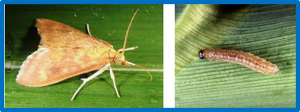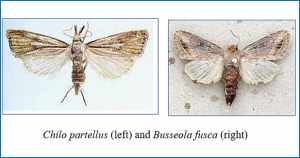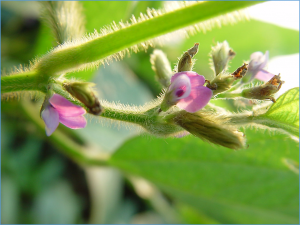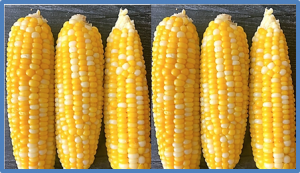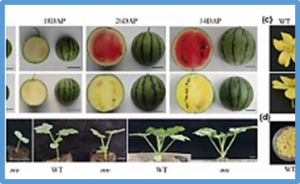Using a stochastic computer simulation, we investigated the benefit of optimization strategies in the context of genomic selection (GS) for pulse breeding programs. We simulated GS for moderately complex to highly complex traits such as disease resistance, grain weight and grain yield in multiple environments with a high level of genotype-by-environment interaction for grain yield. GS led to higher genetic gain per unit of time and higher genetic diversity loss than phenotypic selection by shortening the breeding cycle time.
Grain chalkiness reduces the quality of rice (Oryza sativa) and is a highly undesirable trait for breeding and marketing. However, the underlying molecular cause of chalkiness remains largely unknown. Here, we cloned the F-box gene WHITE-CORE RATE 1 (WCR1), which negatively regulates grain chalkiness and improves grain quality in rice. A functional A/G variation in the promoter region of WCR1 generates the alleles WCR1A and WCR1G, which originated from tropical japonica and wild rice Oryza rufipogon, respectively.
Transmission of reductive and oxidative cues from the photosynthetic electron transport chain to redox regulatory protein networks plays a crucial role in coordinating photosynthetic activities. The tight balance between these two signals dictates the cellular response to changing light conditions. While the role of reductive signals in activating chloroplast metabolism is well established, the role of their counterbalanced oxidative signals is still unclear, mainly due to monitoring difficulties
The tocopherol biosynthetic pathway, encoded by VTE genes 1 through 6, is highly conserved in plants but most large effect quantitative trait loci for seed total tocopherols (totalT) lack VTE genes, indicating other activities are involved. A genome-wide association study of Arabidopsis seed tocopherols showed five of seven significant intervals lacked VTE genes, including the most significant, which mapped to an uncharacterized, seed-specific, envelope-localized,
Using late blight resistance genes targeting conservative effectors of Phytophthora infestans and the constructing gene pyramids may lead to durable, broad-spectrum resistance, which could be accelerated through genetic engineering. Potato (Solanum tuberosum L.) is one of the most important food crops worldwide. In 2020, potato production was estimated to be more than 359 million tons according to the Food and Agriculture Organization (FAO).
The Asian corn borer, Ostrinia furnacalis, is a serious insect pest that can infest corn leaves and stems. Due to its internal feeding behavior, its larvae are not exposed to insecticides that are usually sprayed for pest control. To minimize crop damage caused by O. furnacalis, improving insect resistance trait of corn has been considered as an optimal control tactic. This study screened 27 corn varieties for their insect resistance trait and selected three varieties of Ilmichal (IM)
Stem borers are major insect pests of maize in Uganda. A study was conducted in 2014-2016 to assess the performance of Bt hybrids expressing Cry1Ab (event MON810) against the two major stem borer species in Uganda - the African stem borer (Busseola fusca) and the spotted stem borer (Chilo partellus) - under artificial infestation. The study comprised 14 non-commercialized hybrids, including seven pairs of Bt and non-Bt hybrids (isolines),
From the domestication of wild soybean (Glycine soja Sieb. & Zucc.), over 3,000 years ago, to the modern soybean (Glycine max L. Merr) cultivars that provide much of the world’s oil and protein, soybean populations have undergone fundamental changes. We evaluated the molecular impact of breeding and selection using 391 soybean accessions including US cultivars and their progenitors from the USDA Soybean Germplasm Collection (CGP),
Kernel size and weight are key traits that contribute greatly to grain yield per year in maize (Zea mays). Here, we developed the chromosome segment substitution line (CSSL), H15-6-2, with smaller kernel size and lower kernel weight across environments compared to the background line Ye478. Histological analysis suggested that a slower kernel filling rate of H15-6-2 contributes to its small-kernel size and reduced hundred-kernel weight. We identified a quantitative trait locus (QTL) explaining 23% of the phenotypic variation in hundred-kernel weight.
Watermelon (Citrullus lanatus) has a colorful flesh that attracts consumers and benefits human health. We developed an ethyl-methanesulfonate mutation library in red-fleshed line ‘302’ to create new flesh color lines and found a yellow-fleshed mutant which accumulated ζ-carotene. The initial yellow color of this mutant can be photobleached within 10 min under intense sunlight. A long-term light-emitting diode (LED) light treatment turned flesh color from yellow to pink. We identified this unique variation as photosensitive flesh mutant (‘psf’). Using bulked segregant analysis, we fine-mapped an EMS-induced G-A transversion in ‘psf’ which leads to a premature stop codon in 15-cis-ζ-carotene isomerase (ClZISO) gene.


 Curently online :
Curently online :
 Total visitors :
Total visitors :
